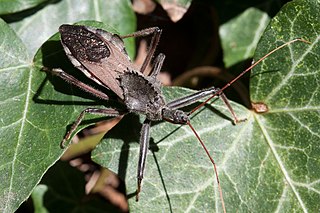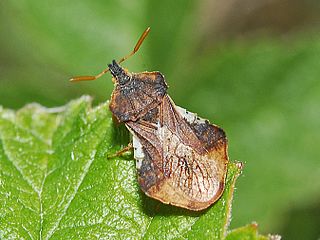
The Reduviidae is a large cosmopolitan family of the order Hemiptera. Among the Hemiptera and together with the Nabidae almost all species are terrestrial ambush predators; most other predatory Hemiptera are aquatic. The main examples of nonpredatory Reduviidae are some blood-sucking ectoparasites in the subfamily Triatominae. Though spectacular exceptions are known, most members of the family are fairly easily recognizable; they have a relatively narrow neck, sturdy build, and a formidable curved proboscis. Large specimens should be handled with caution, if at all, because they sometimes defend themselves with a very painful stab from the proboscis.

Enicocephaloidea is a sole superfamily within the infraorder Enicocephalomorpha of the hemipteran suborder Heteroptera. The group was formerly thought to be related to the Reduviidae because of similarities in head structure but they are now considered different enough from other Heteroptera to constitute a separate infraorder and represents a sister group of the Leptopodomorpha. They are predaceous and some species are known to swarm but little is known of their life history. A few species of enicocephalids are known to shed their wings before entering the surface of subsoil.

The Emesinae, or thread-legged bugs, are a subfamily of the Reduviidae. They are conspicuously different from the other reduviids by their very slender body form. They are stalking, predatory insects that can be collected on palm fronds, cliffs, spider webbing, or near lights at night. They walk on their mid and hind legs; the front pair is raptorial. Some groups specialize on spiders. Very little is known about emesines except that many species are found in the tropics. Pedro Wygodzinsky wrote the most recent revision of this group.

Arilus, or wheel bugs, is a genus of true bugs in the family Reduviidae, subfamily Harpactorinae and tribe Harpactorini. Most species are found in the Americas.

Ploiaria is a cosmopolitan genus of thread-legged bugs (Emesinae). There are presently about 130 described species.
Gardena is a genus of thread-legged bugs in the subfamily Emesinae. It is the second-largest genus in the tribe Emesinii. Presently there are 46 described species.

Emesopsis is a genus of tropical bugs (Heteroptera) from the family Reduviidae. There are at least 22 described species, of which one, E. nubila, also occurs in southern Europe.
Bagauda is a genus of thread-legged bug in the Emesinae. 18 species are currently known. Many of the species of this genus are associated with caves, some exclusively so. Bagauda is synonymous with the genus Pleias Kirkaldy, 1901, but Bagauda has become more widely used. The genus is restricted to Old World tropics.
Gardena insperata is a thread-legged bug species from the genus Gardena. It is found in Tadjikistan and Afghanistan.

Rhynocoris albopunctatus is a species of assassin bug family (Reduviidae), in the subfamily Harpactorinae. It is common in cotton plantations, especially near pastures where Stylosanthes gracilis is incorporated.

Sinea spinipes is a species of assassin bug, family (Reduviidae), in the subfamily Harpactorinae. It is native to North America and found in the midwest along roadsides, forest edges, and open fields with scattered trees.
Tagalis is a genus of assassin bugs in the family Reduviidae.

Sphedanolestes cingulatus is a species of assassin bug belonging to the family Reduviidae, in the subfamily Harpactorinae.

Phymata crassipes is a species of assassin and thread-legged bugs belonging to the family Reduviidae, subfamily Phymatinae.

Rhynocoris iracundus is an assassin and thread-legged bug belonging to the family Reduviidae, subfamily Harpactorinae. The species was first described by Nikolaus Poda von Neuhaus in 1761.

Phymata is a genus of assassin bugs belonging to the family Reduviidae, subfamily Phymatinae, commonly called jagged ambush bugs. They can be a variety of colors, with their coloring helping them camouflage with the plants they live on. They are predators.
Pseudosaica florida is a species of assassin bug in the family Reduviidae. It is found in North America.
Pseudosaica is a genus of assassin bugs in the family Reduviidae. There are at least two described species in Pseudosaica.
Saica is a genus of assassin bugs in the family Reduviidae. There are at least three described species in Saica.

Nagusta goedelii is a species of assassin bugs in the family Reduviidae.












